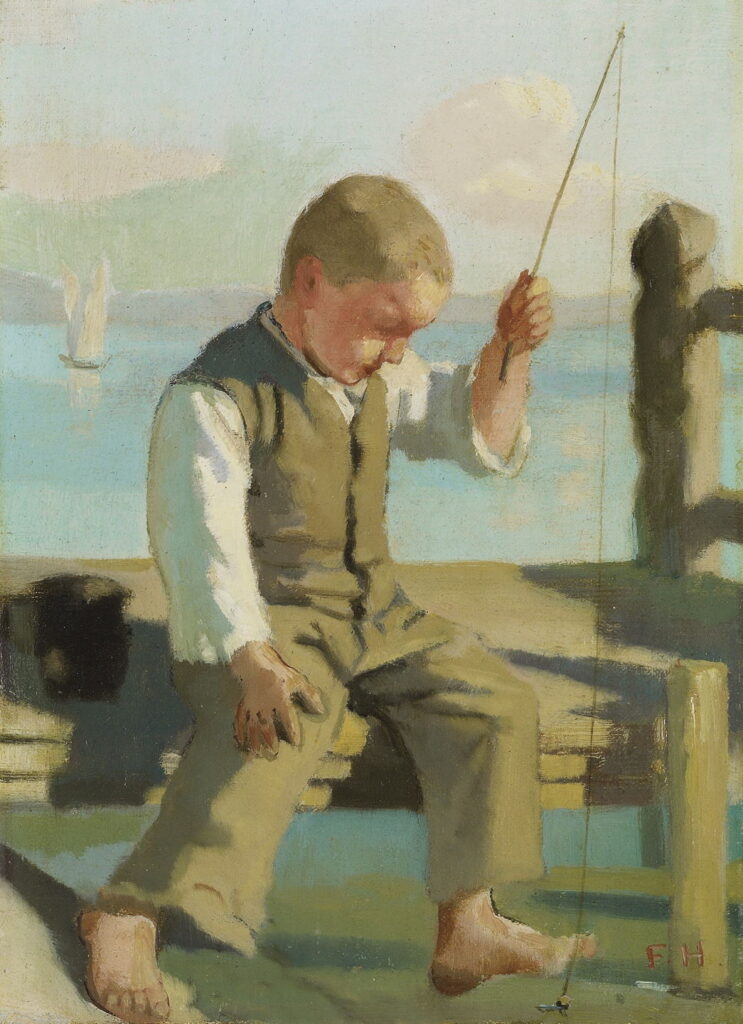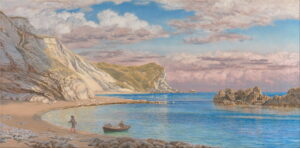Reading visual art: 101 Fishing A

At one time, fishing with a rod and line or angling was claimed to be the most popular participatory sport in Britain. In this and tomorrow’s articles about the reading of visual art, I show examples of paintings including anglers and others catching fish, as opposed to the many views of fishing boats, or fishermen involved in other activities such as repairing nets. Anglers and those engaged in related small-scale fishing are relatively unusual, and may bring their own meaning.
Fishing with a rod and line clearly dates back to ancient times, and features in Ovid’s account of the downfall of Icarus, who was flying with his father Daedalus to escape from the island of Crete. Ovid tells us that the pair flew over a fisherman holding his rod, a shepherd leaning on his crook, and a ploughman with his plough, amazing them with the sight. They flew past Delos and Paros, and approached further islands, but Icarus started to enjoy the thrill of flying and soared too high. As he neared the sun, the wax securing the feathers in his wings softened, the wings fell apart and he plunged to his death.
Joos de Momper (II) (1564–1635), Landscape with the Fall of Icarus (c 1565), oil on panel, 154 x 173 cm, Nationalmuseum, Stockholm, Sweden. Wikimedia Commons.
Joos de Momper’s (II) Landscape with the Fall of Icarus (c 1565) is one of a few similar landscapes showing Icarus’ descent as relatively small events taking place within a much bigger landscape, which includes all three of Ovid’s references. To help the viewer recognise them, de Momper has helpfully painted the men’s clothing scarlet. Up at the top left, Daedalus is seen to be flying well, but Icarus is in an inverted position as he tumbles down.
There are also Biblical references to small-scale fishing using nets on the Sea of Galilee, in particular in the Miraculous Draft of Fishes, resulting in Jesus calling Saint Peter (then known as Simon) and his brother to become “fishers of men”. Soon after Pope Leo X was elected he commissioned Raphael to supply a set of cartoons for a series of ten tapestries to be hung in the Sistine Chapel. Raphael and his workshop painted these on paper using a glue tempera or gouache, and on completion they were sent to Pieter van Aelst’s renowned tapestry workshop in Brussels, where they were woven into tapestries.
Raphael (Rafael Sanzio de Urbino) (1483–1520) and workshop, The Miraculous Draft of Fishes (c 1515-16), glue tempera or bodycolour over charcoal on paper, mounted on canvas, 319 x 399 cm, The Royal Collection of the United Kingdom, UK. Wikimedia Commons.
The first in the series, The Miraculous Draft of Fishes, is based on the Gospel of Luke Chapter 5, verses 1-10, and shows the calling of Saint Peter the Apostle. Peter had been a fisherman working the Sea of Galilee with his brother Andrew and the two sons of Zebedee. The detail below shows Raphael’s mastery of this medium, which was relatively unusual at the time.
Raphael (Rafael Sanzio de Urbino) (1483–1520) and workshop, The Miraculous Draft of Fishes (detail) (c 1515-16), glue tempera or bodycolour over charcoal on paper, mounted on canvas, 319 x 399 cm, The Royal Collection of the United Kingdom, UK. Wikimedia Commons.
Much later, angling acquired the reputation of being a ‘healthy’ outdoor activity for young people to engage in.
Ferdinand Hodler (1853–1918), The Little Fisherman (c 1879), oil on canvas, 22 × 16 cm, location not known. Wikimedia Commons.
The young Ferdinand Hodler’s tiny oil sketch of The Little Fisherman from about 1879 shows a boy fishing on Lake Geneva.
Edward Poynter (1836–1919), Outward Bound (1886), oil on canvas, 49.5 x 49.5 cm, The Tate Gallery (Bequeathed by Henry Evans 1904), London. © The Tate Gallery and Photographic Rights © Tate (2016), CC-BY-NC-ND 3.0 (Unported), http://www.tate.org.uk/art/artworks/poynter-outward-bound-n01948
Edward Poynter’s Outward Bound (1886) shows two boys playing in a small rock cave at the coast. They have a bamboo fishing rod with them, and have made a small boat, which appears to be floating out through the rock arch at the left towards the open sea. Although the phrase outward bound is now more usually associated with the movement started in around 1941 by Kurt Hahn, and Baden-Powell’s scouting movement wasn’t founded until 1910, there were contemporary advocates who promoted getting the poor out of cities to a healthier life in the country and at the coast.
Carl Larsson (1853–1919), Catching Crayfish. From ‘A Home’ (1897), watercolour, dimensions and location not known. Wikimedia Commons.
Carl Larsson’s richly detailed Catching Crayfish (1897) was one of the paintings reproduced in his book A Home. His whole family is involved in catching, cooking, and feasting on the abundant crayfish, in their perfect summer idyll, the aspiration for many who bought his books.
Angling for pleasure rather than subsistence was seen as a fair-weather pursuit, and has thus become one of the symbols of fine weather.
Claude-Joseph Vernet (1714–1789), The Four Times of Day: Morning (1757), oil on silvered copper, 29.5 x 43.5 cm, Art Gallery of South Australia, Adelaide, Australia. Wikimedia Commons.
The first of Claude-Joseph Vernet’s series of Four Times of the Day, Morning, from 1757, shows three people busy fishing at the edge of a substantial river, as the sun rises behind a watermill and trees on the left. The day promises to be fine and sunny once that early morning haze burns off in the sunshine.
John Linnell (1792–1882), Evening, Bayswater (1818), oil on panel, 38.3 x 58.1 cm, Yale Center for British Art, New Haven, CT. Wikimedia Commons.
John Linnell’s Evening, Bayswater from 1818, only two centuries ago, shows what was then a rural part of London, out to the west of what’s now Paddington Station, in more peaceful times before this area was assimilated into the growing city.
In other paintings, the angler’s calm contrasts with the dark sky of a gathering storm.
John Constable (1776–1837), Study for Salisbury Cathedral from the Meadows (1830-1), oil on canvas, 71 × 90 cm, Private collection. Wikimedia Commons.
This half-size and well-developed study for John Constable’s Salisbury Cathedral from the Meadows places an angler in the foreground, as a thunderstorm builds over the Wiltshire countryside behind. Sadly, the fisherman didn’t survive into Constable’s finished painting.
Constant Troyon (1810–1865), The Approaching Storm (1849), oil on canvas on board, 116.2 x 157.5 cm, The National Gallery of Art, Washington, DC. Wikimedia Commons.
The most outstanding of Constant Troyon’s early paintings must be The Approaching Storm from 1849. Set on another river worthy of Constable, two anglers appear to be readying themselves for the torrential rain heading towards them, while others still wander in the last patch of sunshine on the far bank.



